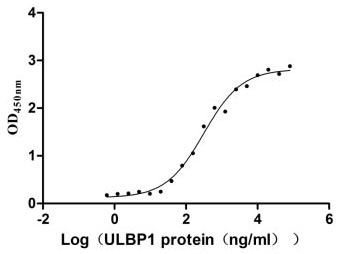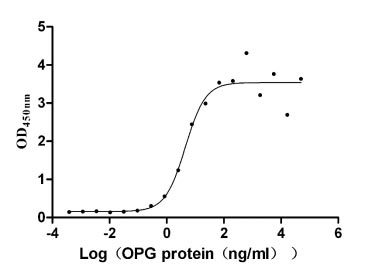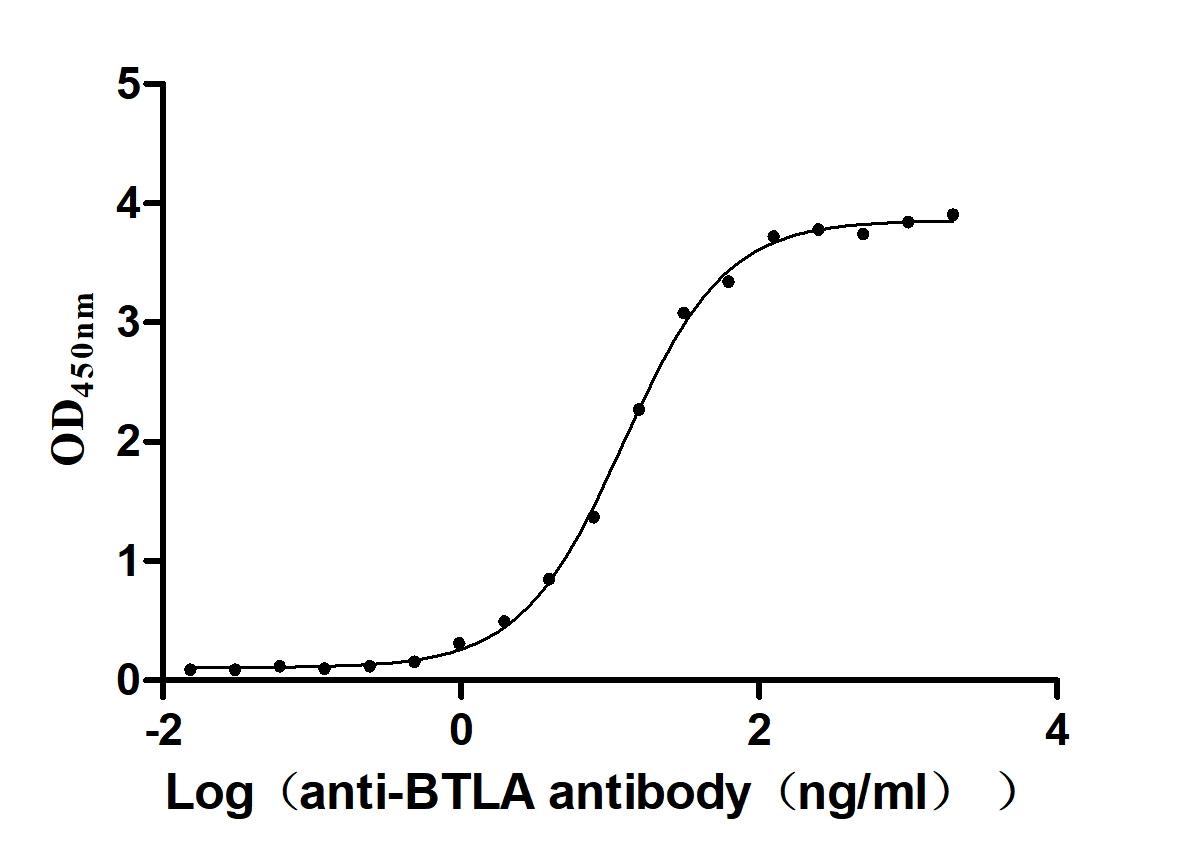Recombinant Mouse CD226 antigen (Cd226), partial
-
货号:CSB-YP817006MO
-
规格:
-
来源:Yeast
-
其他:
-
货号:CSB-EP817006MO
-
规格:
-
来源:E.coli
-
其他:
-
货号:CSB-EP817006MO-B
-
规格:
-
来源:E.coli
-
共轭:Avi-tag Biotinylated
E. coli biotin ligase (BirA) is highly specific in covalently attaching biotin to the 15 amino acid AviTag peptide. This recombinant protein was biotinylated in vivo by AviTag-BirA technology, which method is BriA catalyzes amide linkage between the biotin and the specific lysine of the AviTag.
-
其他:
-
货号:CSB-BP817006MO
-
规格:
-
来源:Baculovirus
-
其他:
-
货号:CSB-MP817006MO
-
规格:
-
来源:Mammalian cell
-
其他:
产品详情
-
纯度:>85% (SDS-PAGE)
-
基因名:
-
Uniprot No.:
-
别名:Cd226; Pta1CD226 antigen; Platelet and T-cell activation antigen 1; CD antigen CD226
-
种属:Mus musculus (Mouse)
-
蛋白长度:Partial
-
蛋白标签:Tag type will be determined during the manufacturing process.
The tag type will be determined during production process. If you have specified tag type, please tell us and we will develop the specified tag preferentially. -
产品提供形式:Lyophilized powder
Note: We will preferentially ship the format that we have in stock, however, if you have any special requirement for the format, please remark your requirement when placing the order, we will prepare according to your demand. -
复溶:We recommend that this vial be briefly centrifuged prior to opening to bring the contents to the bottom. Please reconstitute protein in deionized sterile water to a concentration of 0.1-1.0 mg/mL.We recommend to add 5-50% of glycerol (final concentration) and aliquot for long-term storage at -20℃/-80℃. Our default final concentration of glycerol is 50%. Customers could use it as reference.
-
储存条件:Store at -20°C/-80°C upon receipt, aliquoting is necessary for mutiple use. Avoid repeated freeze-thaw cycles.
-
保质期:The shelf life is related to many factors, storage state, buffer ingredients, storage temperature and the stability of the protein itself.
Generally, the shelf life of liquid form is 6 months at -20°C/-80°C. The shelf life of lyophilized form is 12 months at -20°C/-80°C. -
货期:Delivery time may differ from different purchasing way or location, please kindly consult your local distributors for specific delivery time.Note: All of our proteins are default shipped with normal blue ice packs, if you request to ship with dry ice, please communicate with us in advance and extra fees will be charged.
-
注意事项:Repeated freezing and thawing is not recommended. Store working aliquots at 4°C for up to one week.
-
Datasheet :Please contact us to get it.
靶点详情
-
功能:Involved in intercellular adhesion, lymphocyte signaling, cytotoxicity and lymphokine secretion mediated by cytotoxic T-lymphocyte (CTL) and NK cell. Cell surface receptor for NECTIN2. Upon ligand binding, stimulates T-cell proliferation and cytokine production, including that of IL2, IL5, IL10, IL13, and IFNG. Competes with PVRIG for NECTIN2-binding.
-
基因功能参考文献:
- DNAM-1 (CD226) has been associated with specific inhibitory receptors, suggesting that it might be functionally involved in natural killer cell education. The present study shows that DNAM-1 function is associated with natural killer cell education but is not necessary to reach nor maintain the educated state. The s propose a model in which natural killer cell education prevents or delays downregulation of DNAM-1. PMID: 28561023
- Results indicate that low-grade inflammation coupled with elevated blood glucose increases CD226 expression, resulting in decreased endothelial cell glucose uptake in T2DM. PMID: 26910838
- Data show that the severity experimental autoimmune encephalomyelitis (EAE) were reduced and the serum IL-10 expression levels were increased in CD226 knockout mice than that in control mice when both received EAE induction. PMID: 26942885
- Blocking CD226 inhibited NK cell-mediated cytotoxicity of the GM-CSF-stimulated Flt3 ligand conventional dendritic cells. The CD226(+)NKG2A(-) subset of NK cells was better at targeting GM-CSF-stimulated Flt3 ligand conventional dendritic cells. CD155, a known ligand for CD226, could also act as an inhibitor of NK cell-mediated lysis, as dendritic cells lacking CD155 were more sensitive to NK cell-mediated lysis. PMID: 27034402
- inflammatory monocytes, together with NK cells, are essential in the early control of CMV through the DNAM-1-PVR pathway. PMID: 27503073
- Data show that CD155 protein/CD226 antigen mainly mediates the interaction between NK cells and leukemic cells in acute myeloid leukemia. To investigate the interaction between leukemic cells PMID: 26588911
- absence of either CD155 or CD226 in BALB/c mice causes a profound shift in the Natural Killer T-Cells subtype composition in thymus, expanding the frequency and numbers of iNKT1 cells at the expense of iNKT2 cells, as well as iNKT17 cells. PMID: 26689152
- our results suggest a limited role for DNAM-1 in solid allograft rejection. Blocking DNAM-1 is not sufficient to prevent allograft rejection and might be relevant only in combination with additional inhibitors of costimulation. PMID: 26840537
- we propose that expression of DNAM-1 on inflammatory monocytes are evolutionally conserved and act as an adhesion molecule on blood inflammatory monocytes. PMID: 26675069
- Data indicate that DNAM-1 (CD226) signaling was required to enhance cytotoxicity. PMID: 26552706
- Regulatory T cells derived from Cd226-deficient mice showed similarly reduced inhibitory activity, eventually resulting in an exacerbated disease course of experimental autoimmune encephalomyelitis. PMID: 26359290
- CD226 limits spontaneous multiple myeloma development in Vk*MYC transgenic mice. This is mediated both by NK and CD8+ T cells through perforin and IFN-gamma pathways. It also is needed for cyclophosphamide and bortezomib treatment effectiveness. PMID: 25893601
- Findings suggest that TIGIT is a key checkpoint inhibitor of chronic antiviral and antitumor responses through impairing CD226 function when disrupting its homodimerization. PMID: 25465800
- This synapse defect may explain why DNAM-1-deficient mice cannot clear tumors in vivo. PMID: 24337740
- cooperative signaling through DNAM-1 and Ly49H are required for NK cell-mediated host defense against MCMV infection PMID: 24440149
- An inactivation gene strategy showed that DNAM-1 exerts profibrotic effects by controlling T cell activation and cytokine release. PMID: 23161903
- These observations establish a firm link between the functions of CD155 and CD226 in several T cell differentiation steps. PMID: 22429743
- High DNAM-1 expression is associated with graft-versus-host disease in leukemia. PMID: 23430112
- DNAM-1 -/- CD8 T cells had significant reductions in TNF-alpha and IL-2 that were associated on adoptive transfer with the inability to terminate the persistent Arenaviridae infection. PMID: 22579352
- Intranodal interaction with dendritic cells dynamically regulates surface expression of the co-stimulatory receptor CD226 protein on murine T cells. PMID: 21937446
- Activated CD226-positive natural killer (NK)cells mediate kidney injury in MRL/lpr mice; kidney-infiltrating NK cells display an activated phenotype and a marked ability to produce cytotoxic granules. PMID: 21296979
- mice that received allogeneic splenocytes deficient in DNAX accessory molecule-1 (DNAM-1) had significantly milder GVHD and lower mortality than those that received allogeneic WT splenocytes PMID: 20937876
- CD155 appeared to be a key ligand recognized by DNAM-1 in NK cell-mediated suppression of metastases PMID: 20008292
- We demonstrated that ligand binding of murine DNAM-1 induced a costimulatory signal in antigen-specific CD8+ T cells. PMID: 15752754
- CD226 is a costimulatory molecule that plays an important role in activation and effector functions of T helper type 1 (Th1) cells. PMID: 16034094
- DNAM-1 ligands stimulate innate immunity by in dendritic and natural killer cells, which efficiently prime cell-mediated tumor-specific immunity. PMID: 16249389
- Th1 cells retain up regulate the expansion of CD226 PMID: 16547212
- serine phosphorylation of DNAM-1 primarily induces physical association of DNAM-1 with LFA-1, which then takes DNAM-1 into lipid raft compartment. PMID: 16636013
- These results suggest that, at least in part, the binding of PVR with DNAM-1 negatively regulates osteoclast formation. PMID: 17286202
- During postnatal development, CD226 could not be detected at its adult locations until postnatal day 12; however, it was temporally expressed in the somata of neighboring or distant nuclei associated with its adult location. PMID: 18793698
- These results indicate that DNAM-1 plays an important role in immune surveillance of tumor development. PMID: 19029379
- Results suggest that DNAM-1 serves to extend the range of target cells that can activate CD8 T cell and NK cells, and may be essential for immunosurveillance against tumors and/or viruses that evade recognition by other activating or accessory molecules. PMID: 19029380
- CD226 adheres to CD155 via its first domain; blocking the CD226/CD155 interaction prevents NK-driven killing of immature DC PMID: 19380711
- CD226 is an antiapoptotic molecule that may play an important role in regulating thymus cellularity during murine development. PMID: 19380793
显示更多
收起更多
-
亚细胞定位:Cell membrane; Single-pass type I membrane protein.
-
数据库链接:
KEGG: mmu:225825
STRING: 10090.ENSMUSP00000043551
UniGene: Mm.139293
Most popular with customers
-
Recombinant Human UL16-binding protein 1 (ULBP1) (Active)
Express system: Mammalian cell
Species: Homo sapiens (Human)
-
Recombinant Human Tumor necrosis factor receptor superfamily member 11B (TNFRSF11B) (Active)
Express system: Mammalian cell
Species: Homo sapiens (Human)
-
Recombinant Human Insulin growth factor-like family member 1 (IGFL1) (Active)
Express system: Mammalian cell
Species: Homo sapiens (Human)
-
Recombinant Rabbit Tissue factor pathway inhibitor (TFPI) (Active)
Express system: Mammalian cell
Species: Oryctolagus cuniculus (Rabbit)
-
Recombinant Human C-C chemokine receptor type 8 (CCR8)-VLPs (Active)
Express system: Mammalian cell
Species: Homo sapiens (Human)
-
Recombinant Human B- and T-lymphocyte attenuator(BTLA), partial (Active)
Express system: Mammalian cell
Species: Homo sapiens (Human)


















